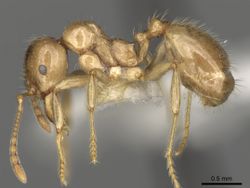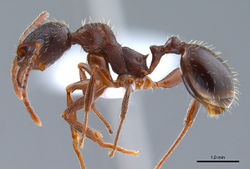Key to Iberian Peninsula Aphaenogaster species
This worker key is based on: Gomez, K., Martinez, D., Espadaler, X. 2018. Phylogeny of the ant genus Aphaenogaster (Hymenoptera: Formicidae) in the Iberian Peninsula, with the description of a new species. Sociobiology 65(2): 215-224 (doi:10.13102/sociobiology.v65i2.2099).
This key is modified from an earlier version posted to hormigas.org
You may also be interested in
1
- Funicular segments 2-6 short, slightly longer than broad .....2
Segmentos funiculares 2-6 cortos, apenas más largos que anchos
- All the funicular segments elongated .....3
Todos los segmentos funiculares elongados
2
return to couplet .....1
- Head striated-reticulated .....Aphaenogaster subterranea
Cabeza estriada-reticulada
- Head punctuated, smooth .....Aphaenogaster dulcineae
Cabeza puntuada, lisa
3
return to couplet .....1
- Body colour from orange-yellowish to dark orange ..........4
Cuerpo de color amarillo anaranjado a naranja oscuro
- Body colour from dark brown to black ..........5
Color castaño oscuro a negro
4
return to couplet .....3
- Propodeal spines very long, its length similar to petiole pedunculum length . . . . . Aphaenogaster cardenai
Espinas propodeales muy desarrolladas, de longitud similar a la altura del propodeo
- Propodeal spines very short, almost reduced to triangular teeth.....Aphaenogaster splendida
Espinas propodeales muy cortas, de longitud mucho menor que la altura del propodeo
5
return to couplet .....3
- Short and powerful mandibles, with the outer margin strongly curved towards the middle line. Major workers converging in cephalic morphology to Messor.....Aphaenogaster striativentris
Mandíbulas cortas y poderosas, con el margen exterior fuertemente curvado hacia la linea media. Las obreras mayores convergen a una morfología cefálica similar a Messor
- Elongated and triangular mandibles, with the outer margin not strongly curved towards the middle line. Head clearly longer than wide, oval. . . . . 6
Mandíbulas elongado-triangulares con el margen exterior no fuertemente curvado hacia la linea media
6
return to couplet #5
- Gaster smooth and polished, shiny . . . . . 7
- Gaster striated, at least in the base, matt . . . . . 8
7
return to couplet #6
- Brown. Head sculpture reticulated. Mesonotum humped, not forming a continuous line with pronotum in profile view. Mesopleurae longitudinally striated - reticulated . . . . . Aphaenogaster gibbosa
- Brownish black to black. Head sculpture parallel striated. Mesonotum not humped, forming a continuous line with pronotum in profile view. Mesopleura longitudinally striated . . . . . Aphaenogaster ulibeli
8
return to couplet #6
- Propodeum with very reduced spines, from non-existent to blunt triangular teeth . . . . . Aphaenogaster gemella
- Spines clearly developed . . . . . 9
9
return to couplet #8
- Long propodeal spines, comparable in size to the petiole pedunculum, curved-triangular shaped and following mesosoma dorsal line, usually curved downwards. Antennal club with four segments . . . . . Aphaenogaster iberica
Espinas propodeales largas, falciformes, siguiendo el perfil corporal y normalmente curvadas hacia la horizontal. Maza antenal de cuatro artejos
- Propodeal spines shorter than the petiole pedunculum, cylindrical and oriented 45º with the horizontal. Antennal club with five segments . . . . . Aphaenogaster senilis
Espinas más cortas, cilíndrica y orientadas a 45º sobre el propodeo. Maza antenal de cinco artejos
References
<references>



















